X-Ray and Radio Studies of the Candidate Millisecond Pulsar Binary 4FGL J0935.3+0901
Dong Zheng,Zhong-Xiang Wang,2,,Yi Xing,and Jithesh Vadakkumthani
1 Department of Astronomy,School of Physics and Astronomy,Yunnan University,Kunming 650091,China;wangzx20@ynu.edu.cn
2 Key Laboratory of Astroparticle Physics of Yunnan Province,Yunnan University,Kunming 650091,China
3 Shanghai Astronomical Observatory,Chinese Academy of Sciences,80 Nandan Road,Shanghai 200030,China
4 Inter-University Centre for Astronomy and Astrophysics,PB No.4,Ganeshkhind,Pune-411007,India
5 Department of Physics,University of Calicut,Malappuram-673635,Kerala,India
Received 2021 September 19;revised 2021 November 16;accepted 2021 November 26;published 2022 February 2
Abstract 4FGL J0935.5+0901,aγ-ray source recently identi fied as a candidate redback-type millisecond pulsar(MSP)binary,shows an interesting feature of having double-peaked emission lines in its optical spectrum.This feature would further suggest the source is a transitional MSP system in the sub-luminous disk state.We have observed the source with XMM-Newton and Five-hundred-meter Aperture Spherical radio Telescope(FAST)at X-ray and radio frequencies respectively for further studies.From the X-ray observation,a bimodal count-rate distribution,which is a distinctive feature of the transitional MSP systems,is not detected,but the properties of X-ray variability and power-law spectrum are determined for the source.These results help establish the consistency of it being a redback in the radio pulsar state.However no radio pulsation signals are found in the FAST observation,resulting in an upper limit on the flux density of~4μJy.Implications of these results are discussed.
Key words:(stars:)binaries(including multiple):close–(stars:)pulsars:general–gamma-rays:stars
1.Introduction
Millisecond pulsars(MSPs)form from low-mass X-ray binaries(LMXBs),in which a neutron star gains angular momentum by accreting mass that is transferred from a Rochelobe filling companion star(Bhattacharya&van den Heuvel 1991).As one type of the end product of binary evolution,a class of so-called“redback”MSP binaries has recently been recognized(Roberts 2013)and gained attention.These close MSP binaries contain a≥0.1M⊙companion star,constituting a class sample that helps reveal not only the LMXB evolution processes(Chen et al.2013;Benvenuto et al.2014)but also intriguing physical properties of compact star binaries(Strader et al.2019 and references therein).Moreover,two redbacks(PSRJ1023+0038 and XSS J12270-4859;Archibald et al.2009;Bassa et al.2014)have been identi fied as transitional MSP(tMSP)systems and several as candidates(e.g.,Miller et al.2020 and references therein):these systems can switch between the states of having an accretion disk(a so-called subluminous disk state)and being a disk-free,rotation-powered radio binary pulsar.Interesting multi-wavelength properties have been seen in tMSPs;for details,see,e.g.,Patruno et al.(2014),Stappers et al.(2014),Takata et al.(2014),Shahbaz et al.(2015),Miller et al.(2020).Generally when in the disk state,no radio pulsed emission is detectable;while in the diskfree state,tMSPs appear like regular redbacks.
The all-sky survey capability of the Large Area Telescope(LAT)onboard the Fermi Gamma-ray Space Telescope(Fermi)has greatly enabled the identi fication of redbacks.Candidate MSPs including redbacks can be selected from unidenti fied sources detected by Fermi LAT,and followup multi-wavelength observations will allow identi fication of redbacks by comparing the obtained properties to those of known systems.Of course,detection of millisecond pulsations and orbitally periodic variations is required in order to identify a redback(otherwise a source would be considered as a candidate).Recently,we identi fied a candidate redback using the approach,for which the source in the Fermi LAT fourth source catalog(4FGL;Abdollahi et al.2020),4FGL J0935.3+0901,was targeted and a 2.5 hr binary was found(Wang et al.2020).Considering the observational facts,the source’sγ-ray variability and curved spectrum,a faint X-ray counterpart(to the binary),and double-peaked optical emission lines(Hα,Hβand He I)of the binary(likely indicating the presence of a~1010cm size accretion disk),we have suggested 4FGLJ0935.3+0901 is a candidate redback and also likely a transitional system in the sub-luminous disk state.
The tMSPs in the disk state have distinctive properties.One is their bimodal count-rate distributions at X-rays(Patruno et al.2014;Bogdanov&Halpern 2015;Coti Zelati et al.2019;Miller et al.2020).Between two distinguishable count-rate levels,a tMSP would switch quickly.Whether 4FGL J0935.3+0901 has this property can be checked with a targeted X-ray observation.The ratios of 0.5–10 keV X-ray fluxes to 0.1–100 GeV γ-ray ones for tMSPs and candidates are~0.3–0.4,signi ficantly higher than those of redbacks(e.g.,Miller et al.2020),but the previously estimated flux ratio for 4FGL J0935.3+0901(at the 0.3–10 keV X-ray band)was only~0.02.This inconsistency thus raises a question about the nature of 4FGL J0935.3+0901 and also about how to explain its double-peaked emission line feature.In addition to being the indicator of an accretion disk,the other possibility that the emission feature might re flect is the intrabinary interaction processes as was discussed in Wang et al.(2020).The latter possibility would suggest the source is a regular redback,and then a pulsar’s pulsed emission might be detectable(note that there are candidate redbacks in which radio pulsars are not detected;see,e.g.,Strader et al.2019).A deep radio observation may clarify the nature of the source.
In order to further study this source,understand its properties and identify its nature,we applied for XMM-Newton and Fivehundred-meter Aperture Spherical radio Telescope(FAST)times for X-ray and radio observations of the source respectively.In this paper,we report the results from these observations.
2.Observations and Data Analysis
2.1.XMM-Newton Observation
We observed 4FGL J0935.3+0901 on 2020 November 12 with the European Photon Imaging Camera(EPIC)onboard the XMM-Newton space telescope.The total on-source observing time was?10.7 ks.The observation(ObsID 0 860 350 101)was conducted in full-frame mode with the thin optical filter used.The data were processed with the Science Analysis Software(SAS)data reduction package(version 18.0.0).Fullfield background light curves in 10–12 keV were extracted for the purpose of checking any presence of particle flares in the pn and MOS1/MOS2 data.No background flares were seen in our data.
J0935.3+0901 was detected at the position of R.A.=09h35m20 9,Decl.=09 00 38.27° ′″ ,with a 1σuncertainty of 0 50(the 1σsystematic uncertainty for the position is 1 5;see Figure 1).The source was faint,with flux approximately equal to that estimated from the Neil Gehrels Swift Observatory(Swift)detection(Wang et al.2020).In order to study its X-ray variability,we chose a source detected in the field as a comparison source.This source,at R.A.=09h34m44 9 and decl.=09° 0 3′ 5 4.″ 72(with a 1σuncertainty of 0 40),was only slightly brighter than our target.We note that this source could be a quasar based on its power-law spectrum(photon index Γ?2.57)and the comparison of its optical and X-ray fluxes(V?18.8 and unabsorbed flux?2.8×10-13erg s-1cm-2,respectively;see,e.g.,He et al.2019).However,we still used this source because other sources in the field were too faint and no signi ficant variability was seen in our following analysis of this comparison source.
To extract photons of J0935.3+0901 and the comparison source,a circular region with radius 24″was used.The same-size background regions,local to the two sources respectively,were used.The best-quality data with FLAG=0 and PATTERN≤4 for pn and PATTERN≤12 for MOS1/MOS2,plus#XMMEA_EP and#XMMEA_EM(for pn and MOS1/MOS2,respectively),were selected and utilized.For variability analysis,we applied the SAS tasks evsel ec t and epi cl c c or r to extract light curve data of the two sources.The final light curves were background-subtracted,produced by combining the data of MOS1,MOS2 and pn.
We also obtained an EPIC spectrum of J0935.3+0901,combined from MOS1,MOS2 and pn data utilizing epi cspecc ombi ne.Each spectral bin contains at least 20 counts.
2.2.FAST Observation
We observed 4FGL J0935.3+0901 with FAST(Nan 2006)on 2020 August 23,lasting 20 minutes from 12:35:00 to 12:55:00(UTC).The Pulsar Backend system was employed,which has 4096 channels in the wave band of 1.05–1.45 GHz.A sampling of 49.152μs was chosen in order to detect millisecond pulsation signals.The observation was conducted with the telescope in tracking mode.
The periodicity search was performed with the pulsar processing software PRESTO(Ransom 2001;Ransom et al.2002,2003).The dispersion measure(DM)from the Earth to 4FGL J0935.3+0901 is likely in a range from 15.0 0 to 28.31 pc cm-3,suggested by the estimated distance range for the source(0.76–2.4 kpc;see below Section 4)based on the YMW16 electron-density model(Yao et al.2017).The time series were dedispersed over DMs in the likely range using a DM step of 0.1 pc cm-3.We applied the accelerated search to retain sensitivity for a possible binary pulsar by setting the zmax value to be 300,and folded the dedispersed time series on the candidate signals identi fied by the ACCEL_si f t subroutine.No convincing pulsation signals were detected.
3.Result
3.1.X-Ray variability
A distinctive feature of tMSPs in the disk state is their bimodal distribution of X-ray count rates with fast(as short as tens of seconds)switching timescales between the two countrate levels(e.g.,Patruno et al.2014).While the faintness of the source hampered our analysis to some degree,we did not see such a feature in J0935.3+0901.In Figure 2,a light curve binned in 100 s in 0.3–10 keV is shown as an example.No phenomenon such that the count rates stay at a high level most of the time and can jump to a~10 times lower level in 10–100 s(see Patruno et al.2014;Bogdanov&Halpern 2015;Coti Zelati et al.2019)is seen.We tested different time bins,such as 10 s and 50 s,but the results were nearly the same.Therefore neither two count-rate levels nor fast switching are evident in X-ray emission of the source.
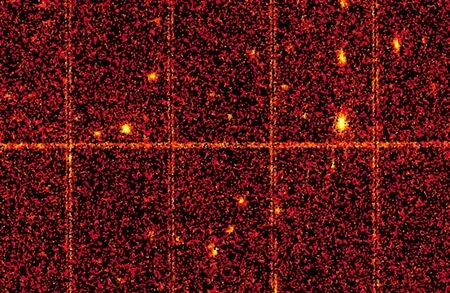
Figure 1.XMM-Newton pn image of the source field,with J0935.3+0901 and a comparison source indicated.
We constructed the count-rate distribution from the 100 s binned light curve of J0935.3+0901,which is depicted in Figure 3.To study any possible differences between it and the comparison source,which would help identify any possible variability of the target,the same distribution of the comparison source was also constructed.It can be seen that the comparison source was brighter,with the distribution peak valueμat~0.11 cts s-1.The value for J0935.3+0901 is at~0.05 cts s-1.We used a Gaussian function,~e xp[ -(x-μ)22σ g)],to fit the two distributions,and obtainedσg?0.036±0.005 for both J0935.3+0901 and the comparison source.Theχ2values were 18.9 and 15.7 respectively(with 11 degrees of freedom).From the fitting,it can be seen that the distributions can generally be described with a Gaussian function.For J0935.3+0901,a couple of data points,for example the one at~0.14 cts s-1,are notably away from the best-fit Gaussian function,which is re flected in the slightly largerχ2value.However,the deviations are not signi ficant.We thus conclude that the two sources have similar count-rate distributions.
Because J0935.3+0901 is a 2.5 hr binary,determined from optical photometry,we also checked its relatively long time-duration variations.A 890 s binned light curve,containing 12 data points,was constructed(Figure 4).We fit the light curve with a constant,and the resultingχ2value was 48.77(11 degrees of freedom).The same analysis was conducted for the comparison source,and theχ2value was 13.93.The X-ray emission of J0935.3+0901 was seemingly variable,by comparing with that of the comparison source.However,the light curves of the two sources appear to have a similar temporal pattern.Their correlation coef ficient was found to be~0.3,suggesting weak correlation.We checked our data analysis for possible background contamination,but no such effects were found.Therefore,we conclude that possible orbital variations were seen in the target.
3.2.X-ray Spectrum
The 0.3–10 keV spectrum of J0935.3+0901,combined from MOS and pn data,is displayed in Figure 5.The spectrum can be fit well with an absorbed power law.Using XSPEC(version 12.10.1f)for the fitting,we obtained a photon index of 1.and hydrogen column density×1020cm-2,where the errors are at a 90%con fidence level(the reducedχ2is 1.15 for 29 degrees of freedom).The resulting 0.3–10 keV absorbed f lux iserg s-1cm-2,and the unabsorbed one is 1.45±0.15×10-13erg s-1cm-2.We note that the Galactic hydrogen column density value(HI4PI Collaboration et al.2016)is slightly lower than what we obtained,but within the uncertainty.
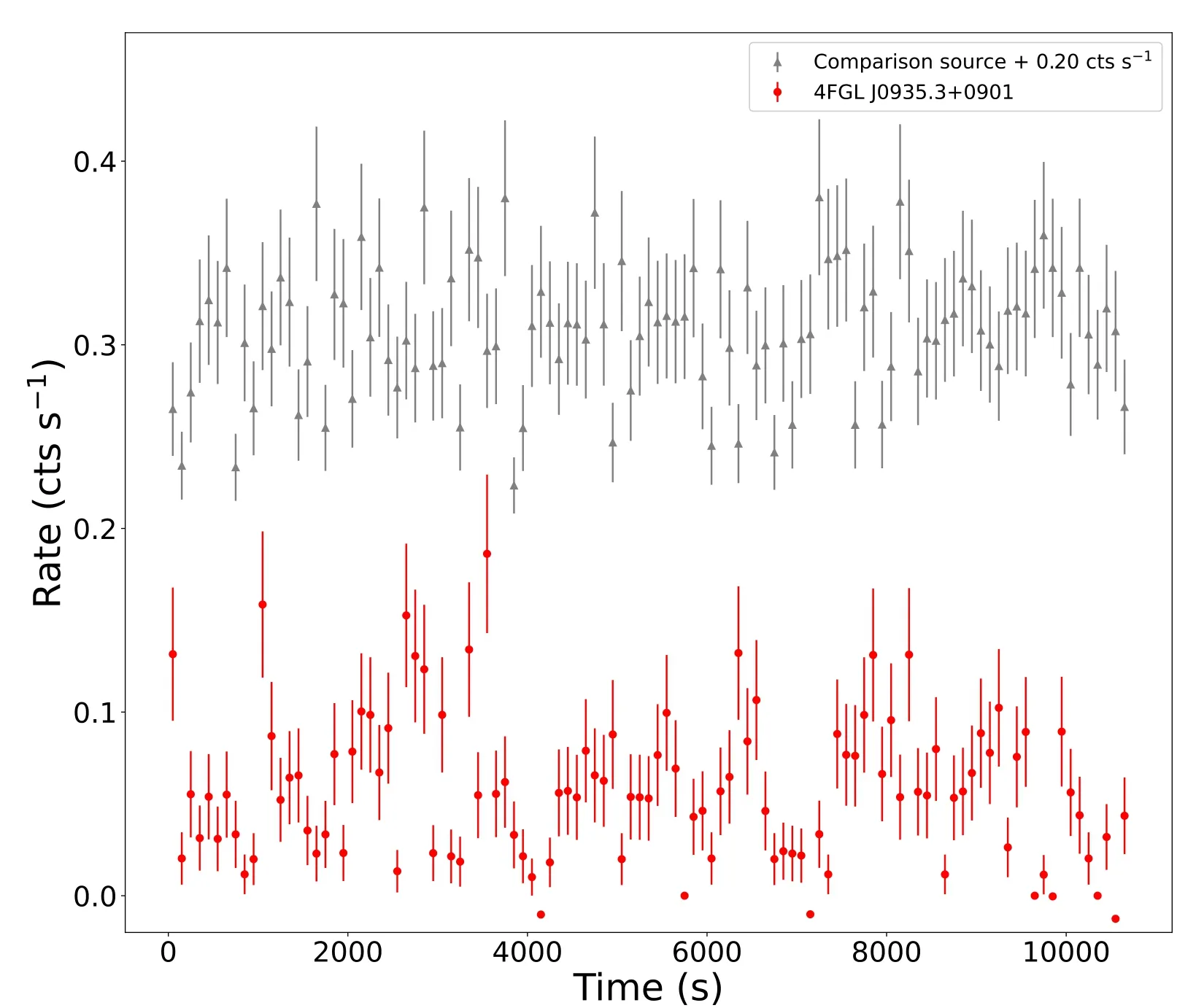
Figure 2.The 100 s binned,background-subtracted X-ray light curve of 4FGL J0935.3+0901 in 0.3–10 keV is plotted.The same light curve of the comparison source is also displayed.For clarity,the latter light curve is upshifted by 0.2 cts s-1.
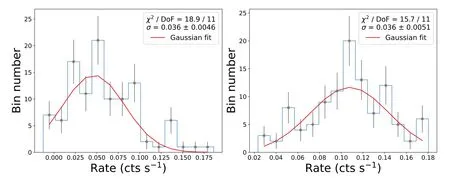
Figure 3.Count-rate distributions for 4FGL J0935.3+0901(left)and the comparison source(right),constructed from the 100 s binned light curves.The best-fit Gaussian functions to each distribution are displayed as red curves.
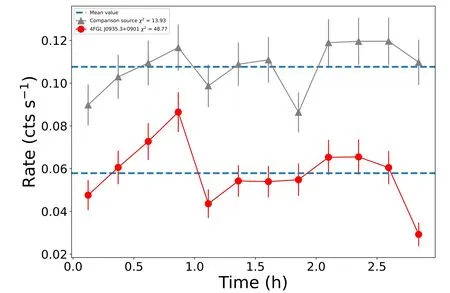
Figure 4.The 890 s binned,background-subtracted light curves of 4FGL J0935.3+0901(red)and the comparison source(gray)are plotted.
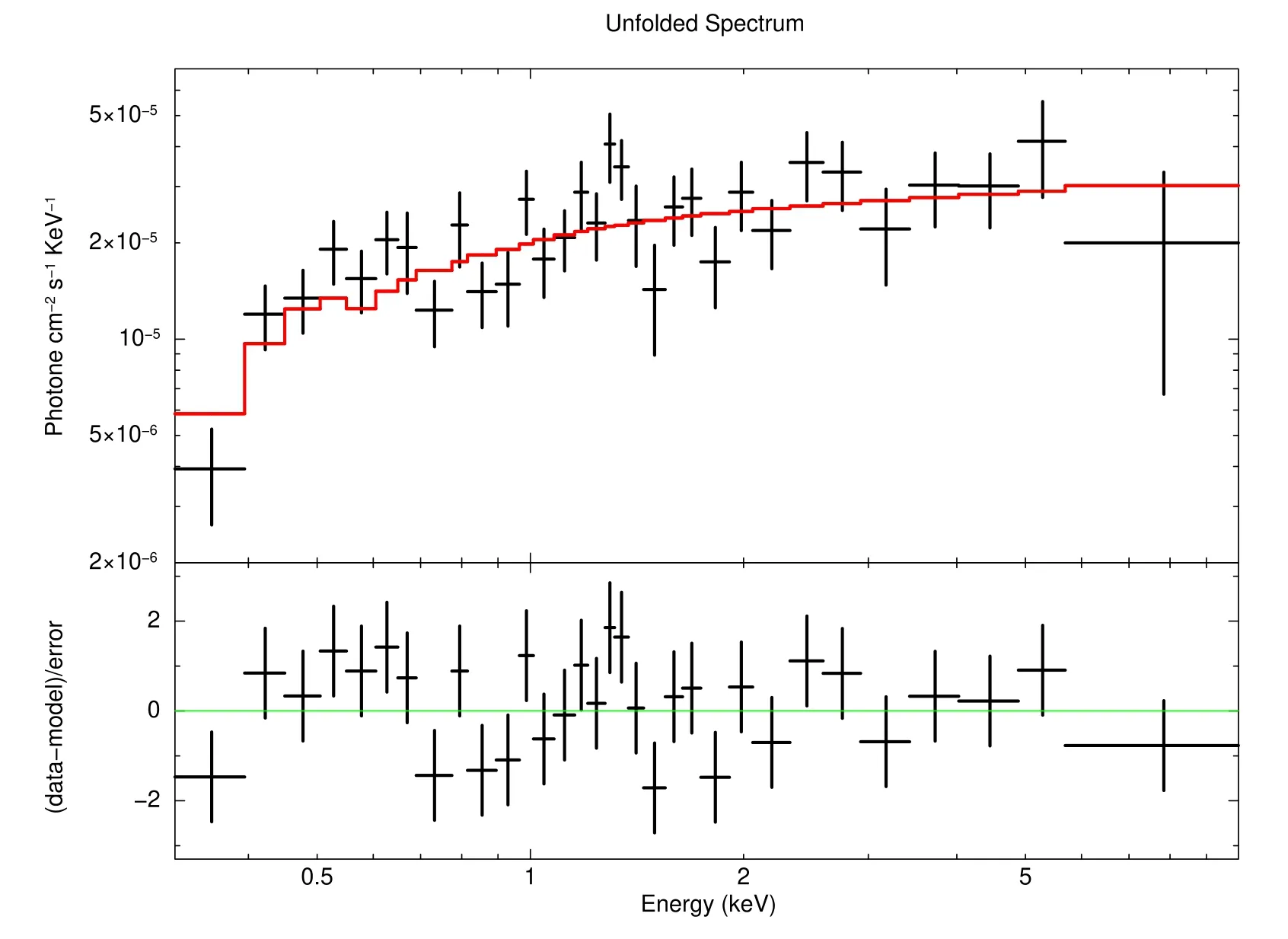
Figure 5.X-ray spectrum of 4FGL J0935.3+0901 in 0.3–10 keV.The spectrum can be fit well with an absorbed power law(red curve).
3.3.FAST Upper Limit
Because no pulsation signals were detected in our FAST observation,we derived a flux density upper limit from the observation.The modi fied radiometer equation(Dewey et al.1985;Patruno et al.2017)

was used,where the correction factorβwas assumed to be 1,the number of polarizationsnpwas 2,the observation timetobswas 20 minutes and the bandwidthΔν?400 MHz.Considering the fundamental performance of FAST described in Jiang et al.(2020),we adopted 20 K forTsys+Tskyand 16 K Jy-1forG,whereTsysis the system noise temperature,Tskythe sky temperature andGthe gain of the telescope.Assuming a pulse duty cycle of 10%(WandPare the effective pulse width and pulse period,respectively),the upper limit value obtained was 0.4μJy when S/N=1.Thus the upper limit on the flux density of 4FGL J0935.3+0901 was~4μJy(when requiring S/N=10).
4.Discussion
We observed 4FGL J0935.3+0901 with XMM-Newton for the purpose of further identifying its nature,whether it could be a candidate tMSP in the sub-luminous disk state.From X-ray variability analysis,we did not find evidence for a bimodal count-rate distribution,which would be expected from a tMSP in the disk state.The XMM-Newton observation con firmed the faintness of the source at X-rays,as the obtained unabsorbed flux was 1.45×10-13erg s-1cm-2,similar to the face value of the X-ray flux obtained from short Swift observations reported in Wang et al.(2020).The X-ray–to–γ-ray flux ratio now is updated to be 0.030±0.007.Both the variability analysis results and the flux ratio value indicate that the source is not a tMSP in the disk state;instead both,plus the X-ray photon index as well(the indices of redbacks are generally in a range of 1–2),are consistent with the properties of redbacks in the pulsar state(Miller et al.2020).
We found that the source’s X-ray emission was possibly variable,but it is hard to determine whether the variability was related to the 2.5 hr orbit because of the limited observation time(?3 hr).Many redbacks in the pulsar state were found to be X-ray variable.They can show clear orbital modulation(e.g.,Bogdanov et al.2011;Linares 2018),flaring-like variations(e.g.,Halpern et al.2017;Cho et al.2018),or weak variations possibly related to binary orbits(e.g.,Li et al.2016,2018).The X-ray variations likely re flect intrabinary physical processes related to pulsar winds,such as the intrabinary shock (Bogdanov et al.2011)or magnetic reconnection in a striped pulsar wind(Al Noori et al.2018).In this respect,the possible X-ray variation of J0935.3+0901 fits the properties of redbacks.According to X-ray studies of redbacks,their X-ray luminosities in the pulsar state are lower than 1032erg s-1(Linares 2014)and can be as low as~1031erg s-1(Strader et al.2019).This would put J0935.3+0901 at a distance of 0.76 kpc (LX1031erg s-1)12,or≤2.4 kpc when requiring its X-ray luminosity≤1032erg s-1.
Considering 4FGL J0935.3+0901 as a redback in the diskfree,pulsar state,an explanation is needed for the doublepeaked emission lines present in its optical emission,as such features are typically seen in spectra of accretion disks around compact stars.The other possibility of arising from an out flow from the companion and/or the intrabinary shock region(see Swihart et al.2018 and references therein)should be the case.The emission features of J0935.3+0901 would be highly variable,which can be veri fied by spectroscopic observations.The existence of the intrabinary material could block the radio pulsed emission,i.e.,the often-seen eclipsing phenomenon in compact MSP binaries,and thus we did not detect the signals at the deep sensitivity level of~4μJy with FAST.Hopefully in the near future,further effort through multi-wavelength observations,including a radio observation covering the whole binary orbit(in order to avoid possible eclipsing phases),may finally be able to provide a clear picture for this source.
Acknowledgments
This research is supported by the National Natural Science Foundation of China(Grant No.11633007)and the Original Innovation Program of the Chinese Academy of Sciences(E085021002).J.V.thanks Prof.C.D.Ravikumar for the support and timely help.
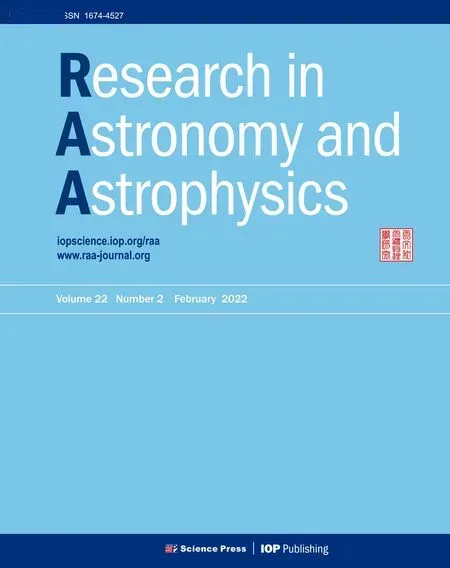 Research in Astronomy and Astrophysics2022年2期
Research in Astronomy and Astrophysics2022年2期
- Research in Astronomy and Astrophysics的其它文章
- Calibrating Photometric Redshift Measurements with the Multi-channel Imager(MCI)of the China Space Station Telescope(CSST)
- The“Bi-drifting”Subpulses of PSR J0815+0939 Observed with the Fivehundred-meter Aperture Spherical Radio Telescope
- Application of Random Forest Regressions on Stellar Parameters of A-type Stars and Feature Extraction*
- Detection of Gamma-Rays from the Protostellar Jet in the HH 80–81 System
- Radio Frequency Interference Mitigation and Statistics in the Spectral Observations of FAST
- Systematic Errors Induced by the Elliptical Power-law model in Galaxy–Galaxy Strong Lens Modeling
